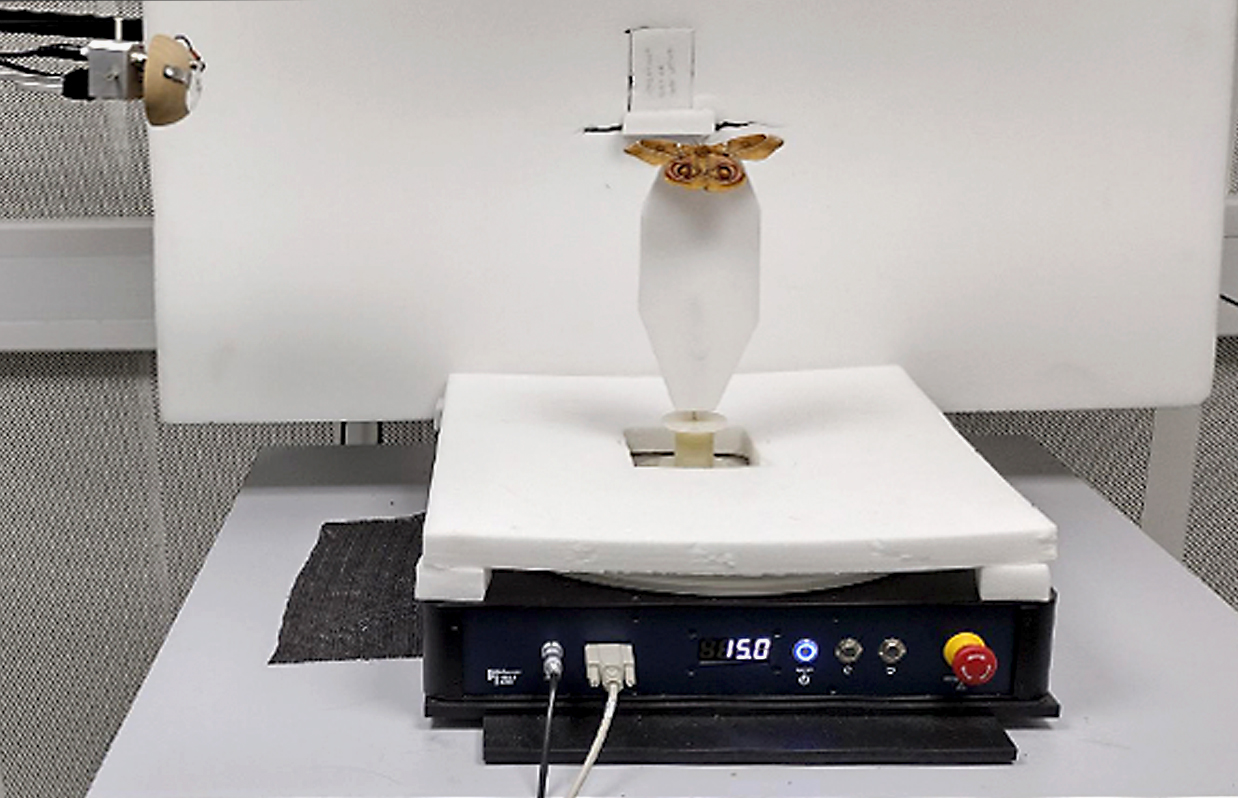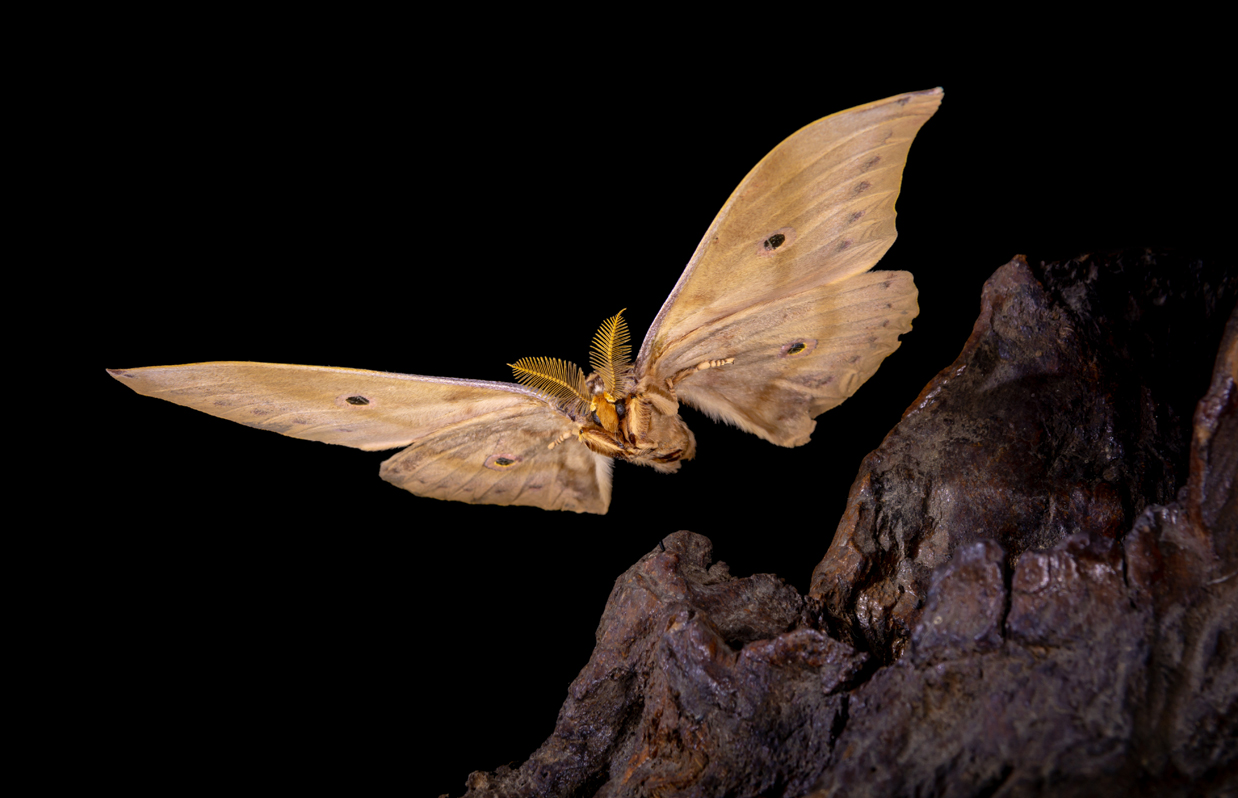
Just a Wing Beat Away from Bioinspired Metamaterial: Absorption Mechanisms of Moth Wing Scales open the Door for New Acoustic Sound Absorbers
Stealthy flier: the Antheraea pernyi moth is very good at absorbing ultrasound. (Courtesy: University of Bristol)
Prof. Dr. Marc Holderied, a sensory ecology and behavioral acoustics expert with strong links to bioinspired engineering, and his team at Bristol University do research in the emerging fields of acoustic camouflage and biosonar navigation. Holderied's passion for "acoustic arms races" and wildlife acoustics led to recent findings about impressive sound absorption properties of air-backed moth wings he could realize with our HEAD acoustics' turntable technology.
Bats and moths have been in an evolutionary arms race ever since. Bats use ultrasonic biosonar to detect their insect prey, which in turn use various strategies to avoid being eaten. In earlier research, Prof. Holderied and his co-researchers discovered how deaf moths had evolved ultrasound-absorbing scales on their bodies that allowed them to absorb 85 percent of the incoming sound energy that bats use to detect them.
A key feature of acoustic metamaterials is that they are much smaller than the wavelength of sound they are acting on, allowing them to be much thinner than traditionally constructed sound absorbers. The need to survive meant that moths evolved a 1.5mm deep scale protective barrier that acts as a porous sound absorber. Such a protective barrier would not work on the wings though, where the increased thickness would hinder the moths' ability to fly.
The Bristol team, led by co-first authors Dr. Thomas Neil and Dr. Zhiyuan Shen, could reveal last summer that moths took one crucial step further: they invented a resonant absorber 100 times thinner than the wavelength of the sound to be absorbed. This clue enables the moths to maintain enough lightness while heavily reducing the potential for bats to detect their wing echoes in flight.
Holderied's and his colleagues' empirical and mathematical analysis showed that moth wings provide vital features of a desirable technological acoustic metamaterial. "We now understand the structural and functional complexity of lepidopteran wings. This way, we seem to have found new ways to design high-performance acoustic panels and noise mitigation devices using these bioinspired metamaterial properties", Holderied explains.
Moth wings act as acoustic metamaterial with broadband absorption – the first known in nature!
Prof. Dr. Marc Holderied, Bristol University
"When moth wings are used to coat hard, artificial surfaces, they can significantly reduce the reflection of incoming ultrasound. The detailed mechanism of this sound absorption is still unclear. Still, it is likely to be a combination of the scales' mechanical absorption, coupled with some dissipation through thermal and viscous effects brought about by the interaction of the scales, wing membrane, and air movement through the scales. Moth wings evolved a way to assemble many resonators individually tuned to different bat frequencies into an array of absorbers, which together create broadband absorption by acting as acoustic metamaterial – the first known in nature. Such a broadband absorption is tough to achieve in the ultrathin structures of moths' wings, which makes it most remarkable!"

Picture 1: 3D representation of a 0.21mm x 0.28mm moth (Lasiocampa quercus) wing section showing structure, diversity, and arrangement of base scales (orange) and cover scales (blue and yellow) Image credit: Simon Reichel, Thomas Neil Zhiyuan Shen & Marc Holderied
Conventional soundproofing materials tend to be porous. To be effective, they must be thicker than about 10 % of the wavelength of the sound they are blocking. Metamaterials made of specially designed structures can be thinner than 1 % of the wavelength they absorb, but these tend to operate over a very narrow band of frequencies. While broadband metamaterials have been created, they tend to be much thicker.
The moth wing scales come in many sizes, each with a characteristic resonance frequency. The different sizes absorb sound across a broad frequency range, making them far more effective than conventional sound-absorbing materials. Previous studies have shown how moth wings absorb sound waves as the insects travel through the air. In their research, Holderied's team looked at how the wings absorb sound when attached to an aluminum disk
Such a hard, manufactured surface will typically reflect most of the incoming sound. In contrast, the researchers observed that the moth-wing coating reduced this reflection by up to 87% at the lowest frequencies they tested. The ultrasound used by the team had wavelengths some 50 times longer than the thickness of the wings.
The team then looked closer at how the wings absorbed the sound. They removed the scales from the wing top and found this caused varying absorption with the orientation of the incoming sound. While its performance remained high when the bald side was facing the incoming sound, it almost completely collapsed in the opposite direction. By recreating this scenario in simulations, Holderied's team showed that the performance of the metamaterial depends strongly on the presence of scales in the air gap between the wing membrane and the hard surface below.
The sound waves absorbed by moth wings may be beyond the range of human hearing. However, by adapting the design to absorb lower frequencies, Holderied and his colleagues hope that new artificial metamaterials inspired by their structure could soon be developed. These structures could lead to breakthroughs in high-performance soundproofing: potentially leading to coatings for walls, vehicles, and noisy machinery that take up a fraction of the space required by existing materials.

Picture 2: Sound absorption research with the high-precision turntable HRT I from HEAD acoustics
Typical applications for our HEAD acoustics high-precision turntable HRT I are automated orientation-dependent acoustic tests where it rotates, e.g., telephony devices, smart home devices, (video-) conferencing systems, loudspeakers, microphones, or an artificial head. This time, helping Holderied and his team scrutinize its wings, a moth was pinned to the turntable (see picture 2) to position it at specific angles in the measurement field and be exposed to sound waves under laboratory conditions. The rotation unit of the turntable offers a 360° rotation range, which can be approached in 0.1° steps. The adjusted angles can be reproduced to an accuracy of 0.02°.
In addition to the control via the measurement and analysis software ACQUA or the software tool RC HRT I, users can also control the turntable stand-alone using programming languages like MATLAB or Python, making HRT I even more flexible to integrate into test setups.
"We are happy to run two HRT I turntables of HEAD acoustics for our moth test series, one placed on a table, the other mounted to the wall. The HRT I turntable operates precisely, robustly, and silently – even when at stillstand – and that is why it was the first choice for the University of Bristol", explains Prof Holderied.
"I hope that the new understanding of the absorption mechanisms of moth wing scales will inspire the next generation of acoustic metamaterial sound absorbers. The promise is one of much thinner sound absorbers for our homes and offices. Our new research paves the way for much more versatile and acceptable sound absorber wallpaper rather than bulky panels."
Thank you very much, Prof. Holderied. We wish you all the best in your further research work!
Sources:
Thomas R. Neil, Zhiyuan Shen, Daniel Robert, Bruce W. Drinkwater, and Marc W. Holderied: Moth wings as sound absorber metasurface. The Royal Society Publishing PNAS. University of Bristol. 2022.
https://doi.org/10.1098/rspa.2022.0046
Wallpaper made of moth wings is an excellent absorber of sound. Physics World. 2022.
Wallpaper made of moth wings is an excellent absorber of sound – Physics World
University of Bristol, Press release 23rd Nov 2020
https://www.bristol.ac.uk/news/2020/october/moths-acoustic-camouflage.html



